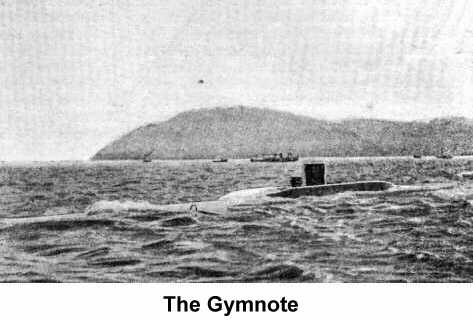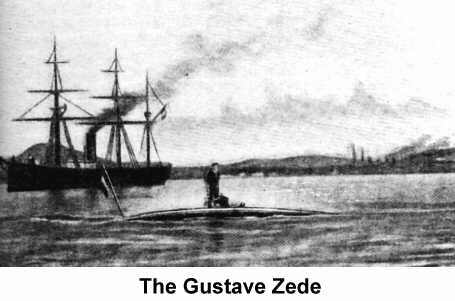I apologise for the quality of the illustrations. The book was in a very bad condition and this was the best I could do.
 The
recent performance of the submarine boat the Gustave Zédé
at Toulon, in the presence of M.Lockroy, have given more satisfaction
to our French neighbours than to our own naval engineers. The value
of this type of boat has probably been over-estimated; nevertheless,
the possibilities of submarine fighting have been indicated and the
results of the manoeuvres will have to be taken into account. Nothing
is known of the details of construction of the Gustave
Zédé since these are kept a close secret, but a few
particulars referring to it and an earlier submarine boat, the Gymnote
are given in the French scientific periodical "La
Nature," from which the accompanying illustrations have been
reproduced. The Gymnote, which
was put on its trial ten years ago, was practically a Whitehead
torpedo nearly sixty feet long and about six feet across at its
widest point. The boat could be made to sink or rise in the water at
will, and when submerged could be made to travel at a constant depth
below the surface. It was only built to determine the practicability
of submarine navigation, and the results obtained with it were so
satisfactory that in 1890 a larger boat of the same type was planned
and eventually named after the engineer, Gustave Zédé,
who designed the original vessel.
The
recent performance of the submarine boat the Gustave Zédé
at Toulon, in the presence of M.Lockroy, have given more satisfaction
to our French neighbours than to our own naval engineers. The value
of this type of boat has probably been over-estimated; nevertheless,
the possibilities of submarine fighting have been indicated and the
results of the manoeuvres will have to be taken into account. Nothing
is known of the details of construction of the Gustave
Zédé since these are kept a close secret, but a few
particulars referring to it and an earlier submarine boat, the Gymnote
are given in the French scientific periodical "La
Nature," from which the accompanying illustrations have been
reproduced. The Gymnote, which
was put on its trial ten years ago, was practically a Whitehead
torpedo nearly sixty feet long and about six feet across at its
widest point. The boat could be made to sink or rise in the water at
will, and when submerged could be made to travel at a constant depth
below the surface. It was only built to determine the practicability
of submarine navigation, and the results obtained with it were so
satisfactory that in 1890 a larger boat of the same type was planned
and eventually named after the engineer, Gustave Zédé,
who designed the original vessel.
 The
Zédé is 130 feet in length, and nearly 10 feet in
diameter at its widest part. Its maximum velocity is fouteen knots
when navigated at the surface and eight or nine when submerged. By
means of an arrangement of mirrors and lenses similar to a camera
obscura the commander can make observations when the boat itself is a
couple of yards below the surface of the water. But this arrangement
is not essential, for when the boat is being navigated on the surface
the only part visible is the dome about eighteen inches in diameter
and the same number of inches high. In warfare the tactics employed
would be to take sight of the enemy through this short conning-tower,
then sink the boat before guns could be directed to it, travel under
water in a straight line for 400 yards or so, and then rise again to
make observations. The enemy would thus be approached by a series of
journeys under water until the distance for projecting a torpedo was attained.
The
Zédé is 130 feet in length, and nearly 10 feet in
diameter at its widest part. Its maximum velocity is fouteen knots
when navigated at the surface and eight or nine when submerged. By
means of an arrangement of mirrors and lenses similar to a camera
obscura the commander can make observations when the boat itself is a
couple of yards below the surface of the water. But this arrangement
is not essential, for when the boat is being navigated on the surface
the only part visible is the dome about eighteen inches in diameter
and the same number of inches high. In warfare the tactics employed
would be to take sight of the enemy through this short conning-tower,
then sink the boat before guns could be directed to it, travel under
water in a straight line for 400 yards or so, and then rise again to
make observations. The enemy would thus be approached by a series of
journeys under water until the distance for projecting a torpedo was attained.
As the Gustave Zédé is propelled by electricity stored in secondary batteries, it has only a small range of action, and cannot move far out of its port. In submarine boats of the Narval type, eight of which have been provided for in the French budget for the current year, the vessel is propelled at the surface by steam and under water by electricity. It is said that the Narval, which will shortly be completed, will carry enough fuel to steam 252 miles in twenty-four hours at twelve knots, or 624 miles in seventy-eight hours at eight knots. While under water it will do twenty-five miles at eight knots, or seventy miles at five knots. When the Narval is ready, we shall probably hear much more about the efficiency of submarine boats as fighting machines.